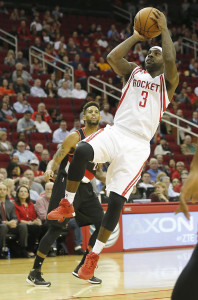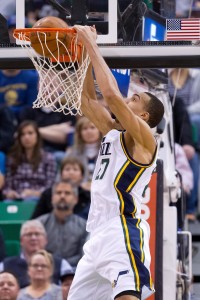Hoops Rumors is in the process of looking back at each team’s offseason, from the end of the playoffs in June right up until opening night. Trades, free agent signings, draft picks, contract extensions, option decisions, camp invitees and more will be covered as we examine the moves each franchise made over the last several months.
Signings
Extensions
Trades
Waiver Claims
Draft Picks
- Sam Dekker (Round 1, 18th overall). Signed via rookie scale exception to rookie scale contract.
- Montrezl Harrell (Round 2, 32nd overall). Signed via mid-level exception for three years, $3.135MM.
Camp Invitees
Departing Players
Rookie Contract Option Decisions
The Rockets were having a wonderful offseason until something went wrong — they started playing games.

Thomas B. Shea/USA TODAY Sports Images
After landing two projected first-round talents in the draft, re-signing nearly everyone from last year’s Western Conference finalists and dealing four spare parts for Ty Lawson, there were championship dreams in Houston. But the early-season reality has been far different. The Rockets have been plagued by a combination of poor shooting, poor defense and poor effort as they stumbled to an embarrassing start that led to the firing of coach Kevin McHale after 11 games.
“We just weren’t playing with any juice, with any rhythm,” McHale told Jonathan Feigen of The Houston Chronicle after the move was announced. “We haven’t been able to get the problems solved. We probably had more meetings in the last six weeks than in my previous four years here. It wasn’t working.”
But it was expected to work, especially after a summer that appeared to be successful in every phase. It started in late June with the draft, where the Rockets were pleasantly surprised with the two players who fell to them. Using the 18th overall pick, which they acquired from the Pelicans in the 2014 trade involving Omer Asik, Houston landed Wisconsin’s Sam Dekker, a 6’9″ sharpshooter out of Wisconsin who was ranked 20th by Jonathan Givony of DraftExpress and 16th by ESPN’s Chad Ford. With the second pick in the second round, acquired from the Knicks in a 2012 deal involving Marcus Camby, the Rockets selected Montrezl Harrell (ranked 24th by Givony, 17th by Ford), a bruising 6’8″ forward out of Louisville known for his tenacity and rebounding. Dekker is expected to be sidelined for about three months after undergoing back surgery November 20th, while Harrell has fallen out of the rotation lately but showed flashes of promise in early-season play.
“I’m very excited,” GM Daryl Morey said to Feigen after the draft. “We got two top-, top-, top-level winners in college on extremely good Wisconsin and Louisville teams.”
With their draft picks in hand, the Rockets set out to keep the core of last year’s Southwest Division champs. Point guard Patrick Beverley signed for $23MM over four years. Reserve swingman Corey Brewer received $23.4MM over three years. Reserve forward K.J. McDaniels, who saw little playing time after coming to Houston in a midseason trade with the Sixers, wound up with a three-year, $10MM deal in late July, and veteran guard Jason Terry, after considering an offer from the Pelicans, decided in late August to remain in Houston, agreeing to the veteran’s minimum of nearly $1.5MM for one year. The only rotation players from 2014/15 who didn’t return were Josh Smith, who accepted a veteran’s minimum contract with the Clippers, and Pablo Prigioni, who also joined the Clippers on a minimum deal after having been included in the Lawson trade and then having been waived by the Nuggets. The Rockets added one outside free agent in Marcus Thornton, who signed a one-year minimum-salary deal worth nearly $1.2MM in July.
Even with the success in other areas, the Lawson trade was supposed to be the centerpiece of the Rockets’ offseason. The seventh-year point guard averaged a career high in assists with 9.6 per game last season, and he was expected to be the second playmaker Houston needed to reduce the burden on James Harden. Not only did he seem like a perfect fit, but his price tag was low, brought down by off-court issues, like a pair of DUI arrests and skipping practice. In return, Houston sent Prigioni, Joey Dorsey, Kostas Papanikolaou, Nick Johnson, cash considerations and a protected draft pick to Denver. The Nuggets subsequently waived all four players.
In one of the conditions of the deal, the Rockets got Lawson to agree to make his $13.2MM salary for the 2016/17 season — the final year of his contract — non-guaranteed. It’s a decision that may limit his time in Houston to one season, or possibly less. The fit the Rockets envisioned hasn’t worked out, and Lawson’s early-season numbers are down in nearly every category. Through 16 games, he is averaging 7.0 points and 4.5 assists while shooting 36% from the floor and 25% from 3-point range. He was pulled from the starting lineup when the Rockets made their coaching change and may be in danger of falling out of the rotation altogether with Beverley returning from injury this week.
The Rockets are dealing with the disconnect between a seemingly successful offseason and a nightmarish November. They’re currently getting nothing from Dekker and Harrell, the players they re-signed over the summer are off to slow starts and the addition of Lawson has been a disaster. A roster shakeup may be necessary to give new coach J.B. Bickerstaff any chance at leading the team back to the playoffs, which means the work Morey did over the offseason may not be complete.
Eddie Scarito contributed to this post. The Basketball Insiders salary pages were used in the creation of it.

